Pixel and Pixel XL review: Google designs its own phones
Everyone else making Android phones should be a little worried.
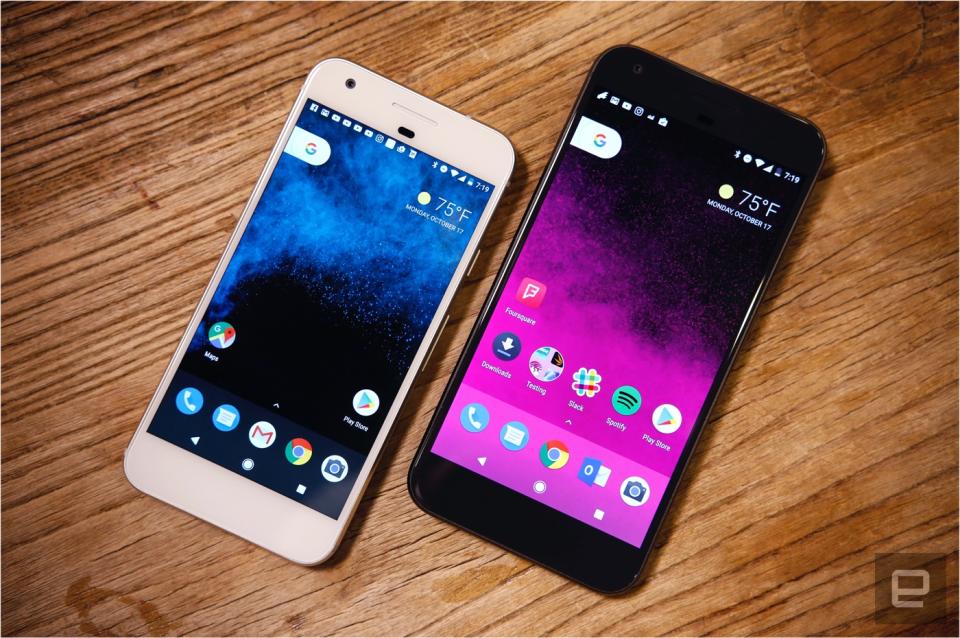
Google's fascination with hardware stretches back years. Remember the early days of Android and the G1? The rise of the Nexus line? Those ill-fated Android@Home lightbulbs and those beautiful Chromebooks? It took Google a while, but that fascination turned into a sort of experimental hobby, and now into something far more serious. Software is Google's art, and the company has been working for a long time to craft the right canvases.
That's where the new Pixel and Pixel XL come in.
Google has more control over the development -- and destiny -- of these two smartphones than it ever had with any Nexus phone. It's not surprising, then, that the company has turned to close friends to help chart this new course. Former Motorola Mobility CEO Rick Osterloh is back at Google heading up hardware after the search giant sold his company to Lenovo. HTC, which most recently worked with Google on the Nexus 9 tablet, is handling the Pixel phones' production and assembly. There's a palpable sense that Google wanted to round up its A-team for this project.
It shows. These Pixel phones are a culmination on Google's part of years' worth of experimenting with hardware, and they're unsurprisingly great.
Hardware
In case the names didn't tip you off, the Pixel ($649+) and Pixel XL ($769+) are identical -- one's just bigger than the other. Both phones are hewn from the same blend of aerospace-grade aluminum and Gorilla Glass, and they're put together with the sort of attention to detail HTC is famous for. The Pixel and the XL feel lighter than they look, which is the sort of thing that could throw old-school HTC fans for a loop: The trademark density of the company's metal designs is noticeably absent.
Don't worry, though: Both versions of the Pixel feel reassuringly sturdy, and comfortable too -- their curved backs nestled nicely into my hands. After years of getting used to bigger and bigger smartphones, I personally prefer the Pixel XL's balance of comfort and usability. The XL is a little shorter and narrower than the iPhone 7 Plus too, which means more people should be able to comfortably use it.
Both phones also have excellent 12.3-megapixel rear cameras (much more on that later), paired with a way-above-average 8-megapixel camera for selfies. Our review units came with 32GB of non-expandable storage, of which 24GB was available from the get-go; needless to say, you should definitely consider the $100 upgrade to the 128GB model. It's worth it.
Moving on, you'll find a USB Type-C port on the bottom edge of either phone, flanked by a microphone and a surprisingly clear speaker. A microSIM slot rests on the phone's left edge, while the headphone jack lives up top. Ready for the sad part? While other flagship phone makers have figured out how to make their devices more life-proof despite those holes, the Pixels will only partially resist dust and water. The exact rating is IP53, but the big takeaway is that these pricey new phones can't deal with dirt or submersion as well as the new iPhones or Samsung's most recent Galaxy devices.
Meanwhile, the differences between the two Pixels are exactly what you'd expect. The Pixel XL has a 5.5-inch Quad HD AMOLED display, a step up from the 5-inch 1080p panel on the regular Pixel. At 3,450mAh, the Pixel XL's battery is among the largest we've seen in a flagship Android phone this year, and it's a clear leap over the 2,770mAh battery used in the smaller model. That's really it. Unlike, say, the iPhone 7 and 7 Plus, which have significantly different camera setups, there's no exciting difference between the Pixel and the Pixel XL.
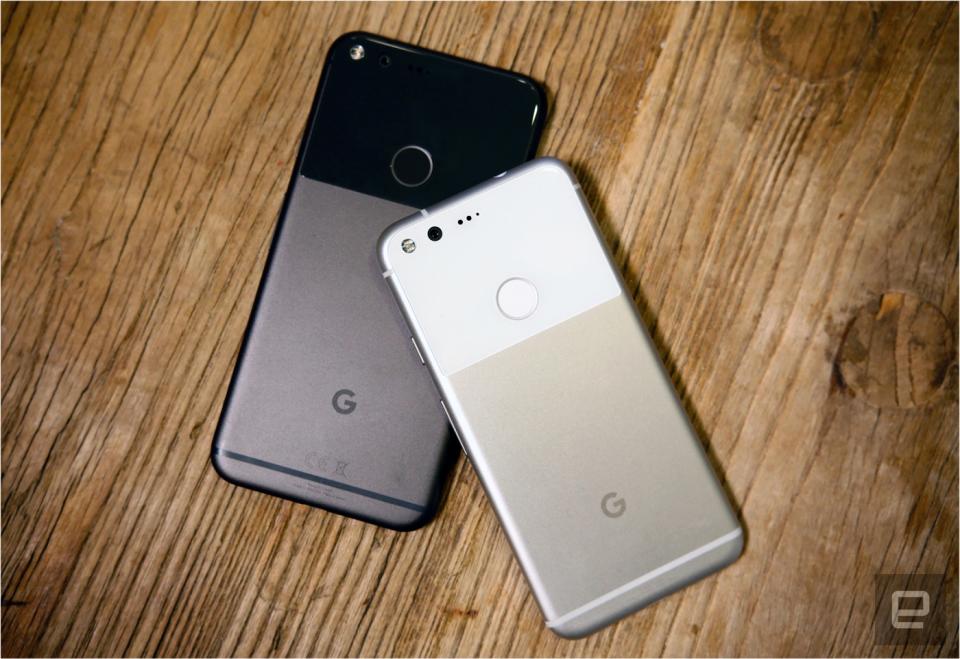
With all that said, I wish the Pixels looked a little more distinctive. The iPhone comparisons are inevitable and not out of line, but even beyond that, there's a distinct lack of character on display here. As I've said, though, Google's true art is software, and one could argue this low-key design was meant to let that software really own the spotlight. That, or Google just doesn't have a great grasp on what beautiful hardware looks like yet.
That would explain why the Pixels' faces are mostly empty except for the front-facing camera, earpiece and infrared proximity sensor that sit above the screen. You'll find that same amount of space below the display too, except it's totally empty -- there's just a big helping of bezel that serves no purpose. The whole thing feels kind of austere, but things start to change when you turn the phone over. There you'll find a pane of very slightly curved (aka "2.5D") Gorilla Glass covering the top third of the phone's back, with one of Google's excellent Nexus Imprint fingerprint sensors sitting near the bottom of the glass.
That glass panel is an ... interesting design choice, to say the least. The reflective glass makes it easy to tell which side is up when you pick up the phone without looking, and it also acts as a window to let RF signals move more easily through the phone. (Think of it as the evolution of the Nexus 6P's trademark black bar.) The glass feels nice and has so far resisted scratches, but the look just isn't for me. A shame, considering it's the one truly distinctive thing about the Pixels' design language. At least the Nexus Imprint sensor does a great job picking up my fingerprints; the Pixels very rarely bugged me for another attempt.

Oh, and while we're still on the subject of looks, the finish that Google calls Quite Black isn't actually black at all. It's more of a gunmetal gray, and while that probably isn't a dealbreaker, it would've been nice to get a Pixel that was properly black, like the gorgeous Note 7. (The Pixels are also available in Very Silver and Really Blue, which are meh and kinda nice, respectively.)
Are you picking up on a theme here? For the most part, the components Google and HTC have stuck in the Pixels are first-rate -- my inner '90s child would even say they're primo. They're just sort of let down by their sense of style, or lack thereof. (It doesn't help either that they can't deal with water very well.) Those are things Google could fix for next year's Pixels (assuming they make any), but the promise of future improvement doesn't do anything for the phones we have here.
Display and sound
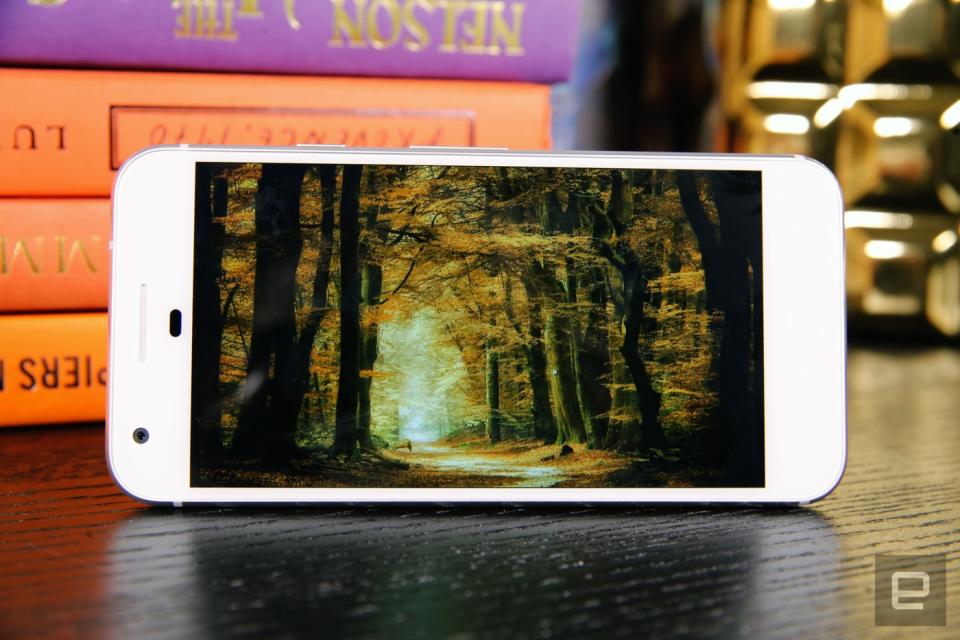
If you were worried that Google would skimp on the screens, relax -- both Pixels have great displays. There aren't any gimmicks here. No curved edges or tiny secondary panels; just crisp, bright AMOLED screens with the sort of punchy, vivid colors these kinds of displays are known for. In fact, I could see colors perhaps being a little too punchy for some people. While the iPhone 7 Plus and its wide color display rendered a mountain scene at twilight with periwinkle skies, the Pixel and Pixel XL made those same skies look bright aqua. Google and HTC's approach is more viscerally pleasing, but whether or not it's better is mostly a matter of taste. Both screens also offer great viewing angles, though you'll notice a little color distortion if you're looking from too oblique an angle.
I've been talking about the Pixel's and Pixel XL's screens in the same breath, but it's worth noting once more that they aren't strictly identical. Beyond the extra detail made possible by its higher-resolution display, the Pixel XL's screen seems a little brighter and its color temperature comes off a touch cooler. That makes all of the stark white found throughout Android and your apps seem crisper, which I actually really like. Don't get me wrong: The smaller Pixel's screen is really quite good, but the XL's blend of Quad HD detail and more pleasant colors make it the one to own if you've got the cash.
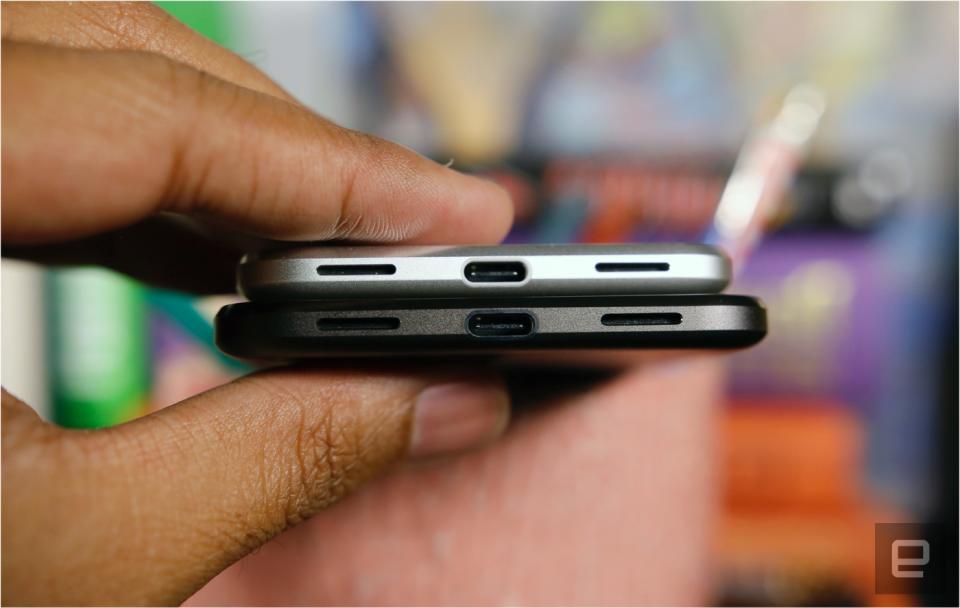
I was pleasantly surprised by the speakers tucked into the Pixel and the Pixel XL, though maybe I shouldn't have been. These phones were built by HTC, after all. Alas, though, you won't find any crazy stereo speaker setups here -- just a single, loud driver wedged into the bottom of each Pixel. These days my diet consists of electro-crooners like Chvrches and Lemaitre, and their respective vocals came through crisply and clearly. Even songs that focus heavily on drums -- like "Caravan" from the Whiplash soundtrack -- fare well, though you'll probably pick up on some muddiness when there are lots of highs and lows banging around at the same time. These speakers certainly won't replace an external set, but they're more than enough to listen to podcasts or sing along with new tracks without feeling like you're missing something.
Software

The Pixels are the very first phones to ship with Android 7.1 Nougat, and, obviously, the first to offer Google's new Pixel Launcher experience. There's a lot to unpack, so let's talk about the core first: Android 7.1. Google was quick to call this new build an "incremental update" that builds on the progress made with the still-new Nougat update. (You can sift through our full Android 7.0 review here.) Incremental is right. Beyond the usual batch of bug fixes and system optimizations, there are only a handful of new features to play with.
Funnily enough, the most notable addition is also the one you're most likely to discover by accident. Long-pressing certain app icons now brings up a list of actions you can jump straight into, much like how Quick Actions work with 3D Touch as of iOS 9. The thing is, Apple's approach is more elegant. In iOS, you have to physically press the screen to access those shortcuts, a step that makes accidental actions unlikely. Here, though, you can't tell which apps have shortcuts until you long-press them; if there aren't any shortcuts, Android thinks you want to move that app icon to your home screen.
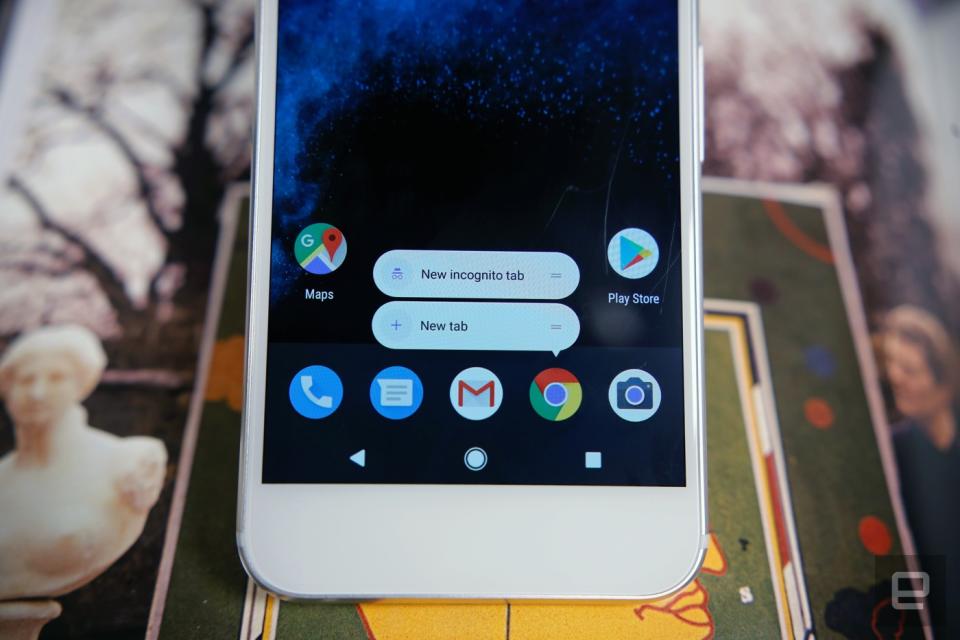
Since the Android 7.1 developer preview won't go live until later this month, the only apps that have these shortcuts enabled are ones made by Google -- long-pressing the Gmail icon offers a "compose" option, while doing that to the Calendar icon lets you quickly create a new appointment. All told, 17 of the preloaded Google apps have shortcuts for you to play with, and they're useful if you remember they're there. Thankfully, you can grab those shortcuts and drag them to your home screen for even quicker access.
Android 7.1 also brings the ability to send images straight from keyboard apps, so it's easier than ever to harass your friends with GIFs. Developers can build support for GIFs, stickers and other image formats into their keyboards, but Google's approach is already pretty damn useful. When pecking out a message in a compatible app -- like the stock Messenger -- tapping the emoji icon also reveals a GIF window you can use to search for the perfect animation. And yes, there's some naughty-ish stuff to be found. Google has blocked most of the really vulgar images, but you can definitely get more crude than you can on iOS. Throw in support for round app icons (like the ones on the Pixels), along with Daydream support (which I wasn't able to test yet), and we've already covered the biggest changes to Nougat.
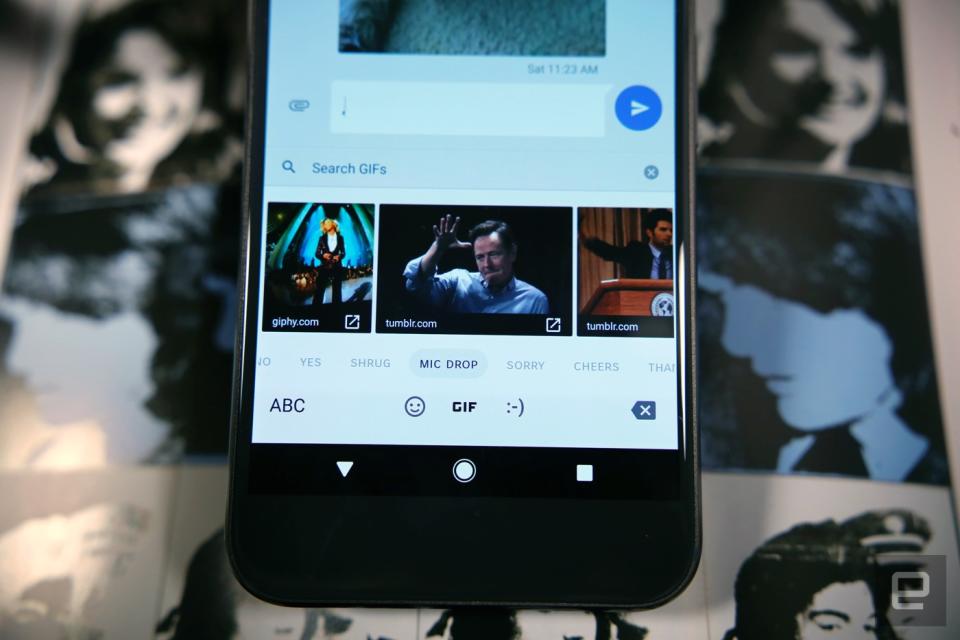
Now, about you Verizon customers. You can buy the Pixels straight from a carrier store, but you'll have to deal with a little software meddling in the process. I tossed a Verizon SIM into one of my review units during the setup process, and wouldn't you know it -- the phone started downloading three Verizon apps from the Play Store. Verizon's Messages+ and the Go90 streaming service got the uninstall treatment immediately, but the My Verizon account management app can be pretty helpful. I'm still curious to see how Verizon does with its promise to keep big software updates rolling out to Pixels in a timely fashion, but at least it took a light touch with bloatware this time.
The Pixel advantage
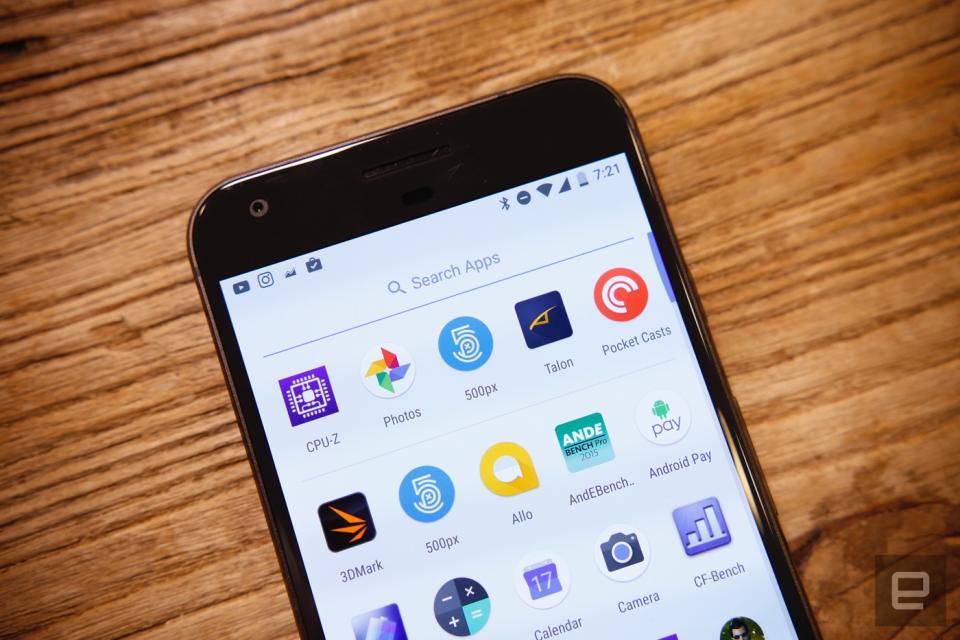
Google wants you to feel special for buying into its vision of mobile computing -- that's why it's sweetening the deal with features you won't get on any other Android phone. Some of them are mostly cosmetic, like the redesigned setup flow and a calendar icon that shows you what the date is. Others, like the revamped Pixel Launcher interface, take a little more getting used to. All your Google Now cards still live to the left of the main home screen, but the conspicuous app launcher button is gone.
You can tap a tiny arrow above the favorite-apps tray to open the launcher if you really miss the old-school button; otherwise, the easiest way to go is to just swipe up from the bottom of the screen. That new swipe gesture feels natural, because it thematically mirrors how you pull down the notifications shade, and as far as I'm concerned, there's no going back. That persistent search bar is gone as well, which has thrown off just about everyone I've shown these phones to. The wallpaper picker has changed too, and Google has seen fit to trick out the Pixel and Pixel XL with some of the sweetest options I've seen on an Android device. Seriously: Thank you.
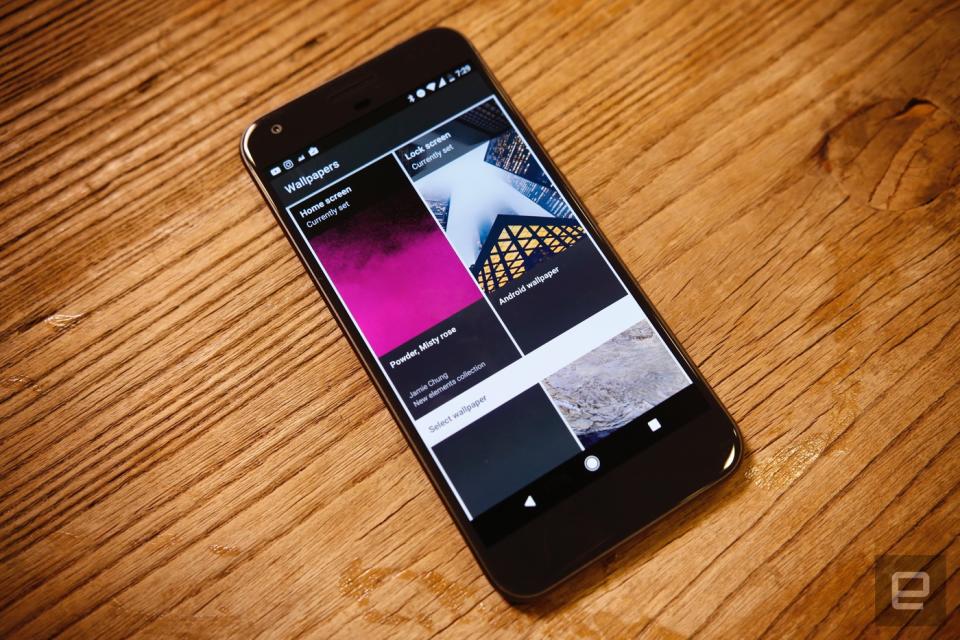
The rest of the Pixels' exclusive features are pretty damn valuable. These phones come with unlimited full-resolution backups of photos and videos to Google Photos; everyone else can only store downsampled versions of photos for free. Since all that media can be backed up to the cloud automatically, you probably don't need it on the phones themselves. That's where the Pixels' exclusive Smart Storage feature comes in -- when you've blown through your 32GB or 128GB of storage, Android automatically clears up space by deleting photos and videos that have already been backed up. Feeling desperate for more space? You can manually force a cleanup, though your photos, videos and apps have to have gone untouched for a while before the system will let you trash them en masse.
Pop into the settings menu and you'll also see a new tab for support -- in case something goes awry, you can reach out to a Google rep to help you walk through things. During my testing, I managed to contact a technician in just a few minutes. They can be surprisingly helpful, too; you can even share your screen with them so they can see what's going on. I just hope this level of service doesn't drop off when more people start using these phones.
Google also made it surprisingly easy to migrate data from your old phone to your new Pixel, even if that old phone was made by Apple. I tried hooking up an iPhone 7 Plus to the Pixel XL during the initial setup process, and after about seven or eight minutes of chewing, my contacts and SMS threads appeared in their respective Android apps. Google didn't have to do this, but building a near-seamless way to help someone give up his or her old phone is seriously savvy.
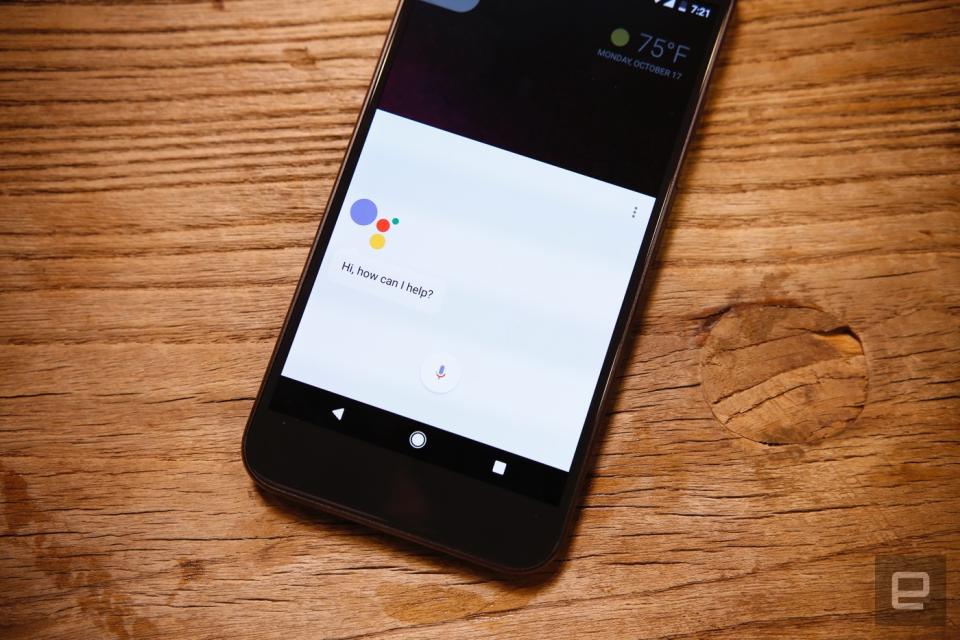
And then, of course, there's the Google Assistant. If you've installed Allo, Google's new cross-platform messaging app, you're probably already acquainted. If not, it's dead simple to start chatting with it. Just hold down the home button or run through the voice training process and say, "OK Google." Familiar, no? From there, just start gabbing away. The Assistant can launch apps, find restaurants and points of interest nearby, translate things you say into different languages, and even just get answers to random questions. (As it turns out, Vladimir Putin is 64 years old.) I've been consistently surprised at how accurate its voice recognition has been too, since I tend to get a little mumbly from time to time.
Also impressive is how the Assistant can "remember" the context of a line of questioning, so you can speak to it the way you would to a person. Let's go back to that weird Putin example: After asking how old he is, I asked the Assistant, "Is he married?" The Assistant didn't skip a beat and confirmed that he had been until 2014. Machine learning has grown sophisticated enough for these interactions to become common -- Siri started tracking context with the launch of iOS 9 -- but it's still terribly neat to see in action.
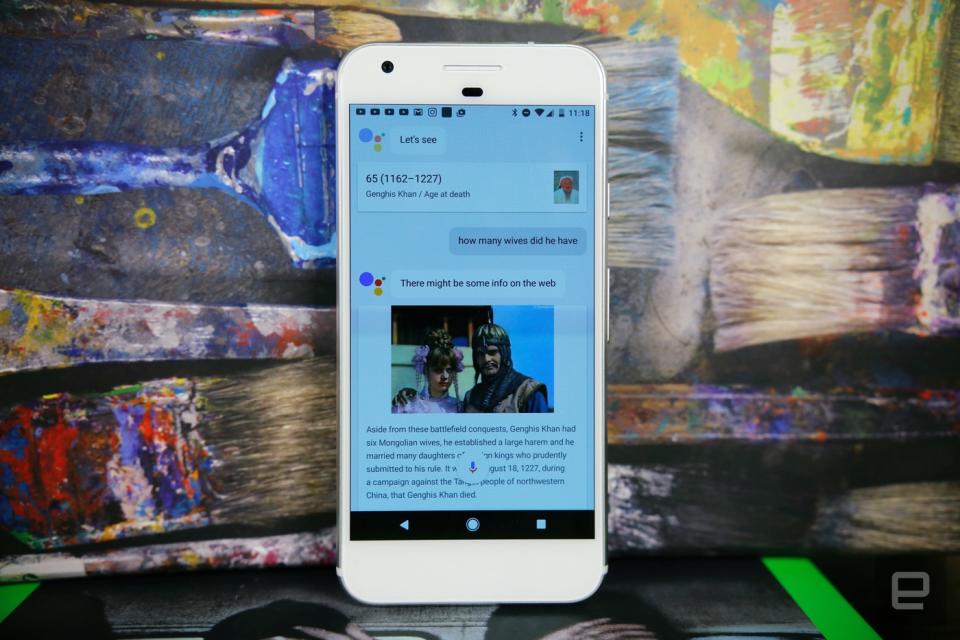
All told, Google's Assistant is a surprisingly thoughtful system as long as you play within the range of prescribed actions. When it can't figure out a more appropriate way to respond, the Assistant just defaults to reading web search results. More often than not, though, those little tidbits read aloud were at least enough to point me in the right direction. Unfortunately, many of the third-party integrations Google showed off at its Pixel launch event don't work yet, so you won't be hailing Ubers or reserving a table at the Smith using just your voice.
Camera
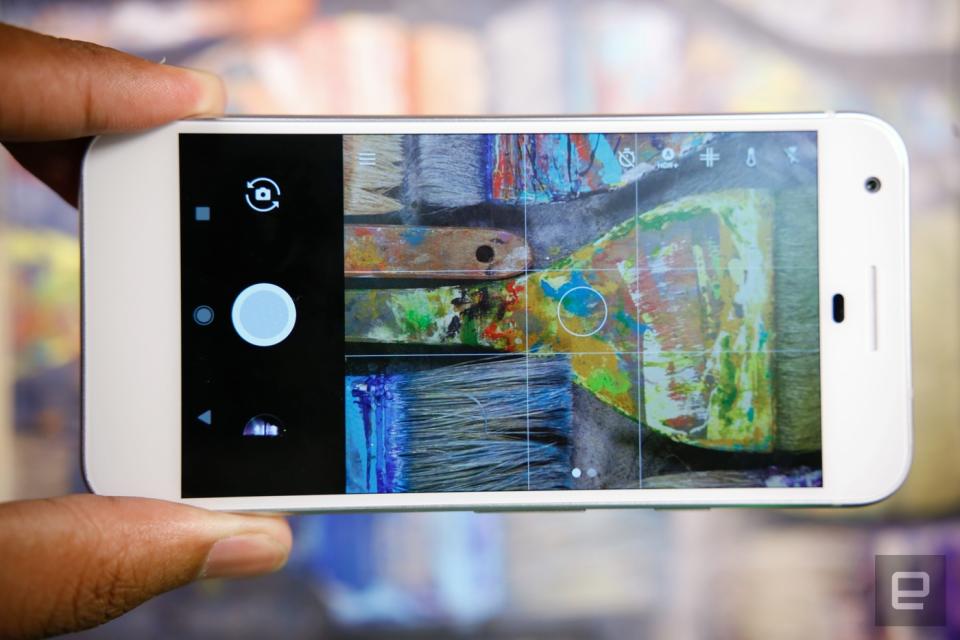
Google didn't pull any punches at its Pixel unveiling -- VP Brian Rakowski proudly proclaimed that the cameras in these smartphones are the best anyone has ever made. And the kicker? A review from the independent mobile camera testers at DxOMark giving the Pixel and Pixel XL the top spot in its photographic rankings.
While not perfect, Google's pair of Pixels can indeed capture fantastic photos -- detailed and crisp, with mostly correct colors. It shouldn't surprise you to hear that the Pixel and Pixel XL excel in bright conditions, but their cameras are actually remarkable in dim situations too. That's partly due to the optics Google ran with here. The 12.3-megapixel cameras have a f/2.0 aperture -- that's not quite as wide an opening for light as on the iPhone 7, but still pretty good. The pixels on those sensors are pretty large too, at 1.55μm -- a trait this Sony sensor shares with last year's Nexus 6P.
That's just part of the story, though: Google's HDR+ mode is back and works much better than it has in the past. Remember, many HDR camera modes capture one long exposure and then process that image to crank up the clarity and dynamic range. The Pixels' HDR+ modes, meanwhile, capture briefer exposures and basically stitch them together, reducing the likelihood of hand-induced blur. Thanks to the extra horsepower afforded by the Pixel's beefy chipset and a Hexagon coprocessor, that process is much faster now, resulting in more appealing shots in both dim and bright conditions without delay. It doesn't always work when you're shooting rapid-fire, but in general this is the first HDR mode I've wanted to leave on all the time.
Like I said, though, the Pixels' cameras aren't perfect. I occasionally noticed that the hybrid laser-and-phase-detection autofocus system got skittish while trying to lock onto a subject. Neither camera has optical image stabilization either, though the included electronic image stabilization does a good job keeping blur from becoming an issue. This is especially apparent when you're shooting video, as long as you're not expecting miracles. There's still some jitter to be found from time to time, alas.
The beauty of everything I just mentioned is that it generally happens behind the scenes. Google's Pixel camera app is more than happy to let you shoot in Auto (and get some impressive photos in the process), but persnickety photographers will appreciate the ability to lock exposure and focus and overlay grids over the live image to more easily frame up shots. If that's not you, well, you'll probably still enjoy Google's Smartburst feature, which lets you hold down the shutter button to capture a slew of shots in one go. From there, the phone stitches those frames together into a GIF (!) and lets you choose the best individual stills to keep.
Performance and battery life
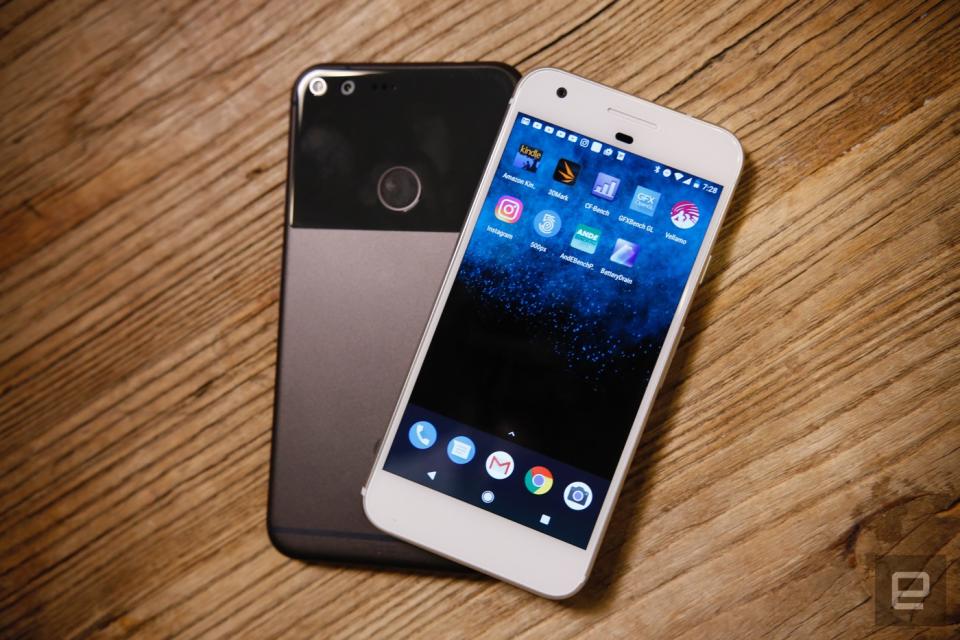
Here's an interesting tidbit to chew on: Qualcomm says the Snapdragon 821's clock speed tops out at 2.4GHz, but the version used in both Pixel models is capped at 2.15GHz. In case you haven't been keeping track, that's as fast as the trusty Snapdragon 820s we've seen in just about every other flagship smartphone this year. Despite that, the Pixel and the Pixel XL feel snappier and more responsive than most of the other flagship phones I've tested this year. What gives? As far as Google was concerned, the real trick here was balancing sheer horsepower with battery life, so using a slightly slower version of the chipset seemed like the way to go. Google wasn't willing to sacrifice the sensation of speed, though, so it optimized how things were rendered on-screen, reduced touch latency and improved app launch times.
That said, you'd be wrong to think the Pixels were lacking in sheer processing power. My days include lots of frenzied multitasking -- think Slack, Outlook, YouTube, Spotify, Twitter, Instagram and more -- along with games like Mortal Kombat X and Brothers: A Tale of Two Sons. Nothing, and I mean nothing, during this testing period managed to make the Pixel or Pixel XL break a sweat. Sure, they got a little warm from time to time, but their performance left me with no complaints.
Google Pixel | Google Pixel XL | Samsung Galaxy S7 Edge | HTC 10 | |
|---|---|---|---|---|
AndEBench Pro | 14,941 | 16,164 | 13,030 | 16,673 |
Vellamo 3.0 | 5,343 | 5,800 | 4,152 | 4,876 |
3DMark IS Unlimited | 28,645 | 29,360 | 26,666 | 26,747 |
GFXBench 3.0 1080p Manhattan Offscreen (fps) | 46 | 48 | 47 | 48 |
CF-Bench | 30,997 | 39,918 | 46,290 | 49,891 |
Neither did the Pixels' batteries, as a matter of fact. Consider Engadget's standard rundown test, wherein we loop high-definition videos with the phone connected to WiFi and the screen brightness fixed at 50 percent. The more capacious XL was the obvious standout here -- it lasted 14 hours and 12 minutes, beating out the Galaxy Note 7 by just seven minutes. The smaller Pixel, meanwhile, managed 12 hours and 26 minutes before finally needing a trip to a power outlet.
Thankfully, both phones proved to be serious contenders in day-to-day use as well. After a full day of work, the XL would typically hover around 46 percent, and then, when my schedule quieted down, it just sipped on its remaining power. All told, I could reliably squeeze a day and a half of use out of it on a single charge, or closer to two workdays, even, when I took things slow.
The smaller Pixel fared well too, sticking around for a full day and clinging to life the next morning. You shouldn't feel too bad about forgetting to charge your Pixel before crashing, though: Google says the included fast charger will give you seven hours of usage after just 15 minutes plugged in. Your mileage may vary, but in general, I found leaving the Pixel and XL plugged in for 15 minutes added a 15 and 20 percent charge, respectively.
The competition
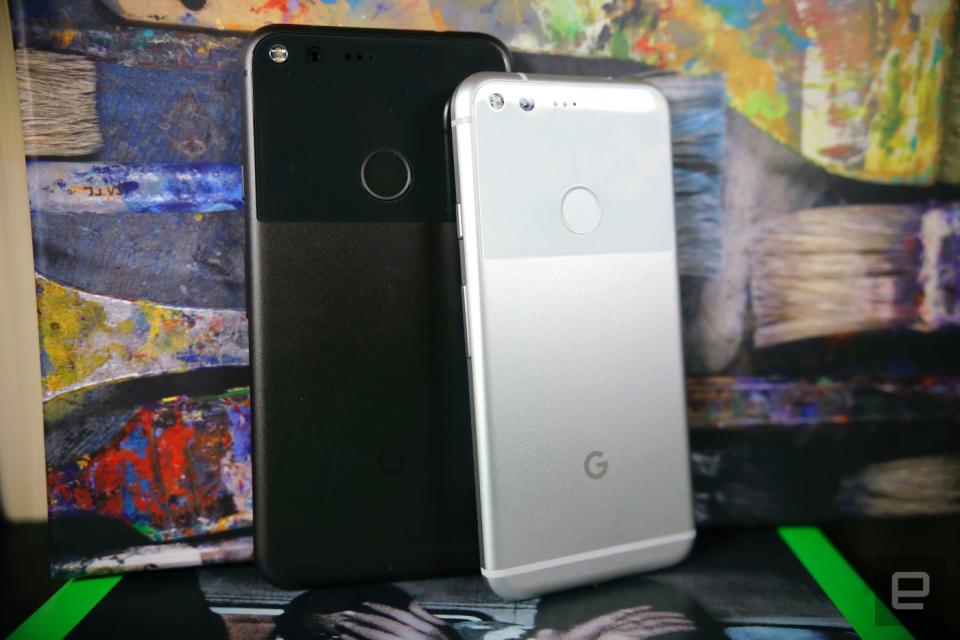
Now that the Galaxy Note 7 has been permanently discontinued, Samsung's heirs apparent to the Best Smartphone crown are the Galaxy S7 and S7 Edge. Before using the Pixels, I liked to think of these phones as the best all-around mobile cameras, and even now the race is closer than Google would like to admit. Beyond photography, they're impeccably built, gorgeously designed and powerful enough for just about anyone's daily routine. Still, having to deal with TouchWiz -- even in its improved form -- probably wouldn't sit well with the kind of people who would be drawn to the Pixel line in the first place.
The HTC 10 also runs a tweaked version of Android in the vein of TouchWiz, but you'd wind up with a device that shares some traits with the Pixels. Incredible build quality? Check. Speedy performance and almost no touch latency? Yep. A stunning camera? Well ... about that: The 10's 12-ultrapixel camera sensor has pixels just as large as what you'll find on the Pixel and Pixel XL, but Google's phones have a distinct edge.
Finally, for people not strictly married to Android, there's the iPhone 7 and 7 Plus. Apple basically recycled their design from last year, but looks are deceiving -- they're actually the company's most technically impressive phones to date. Apple's improved camera game puts the 7 and 7 Plus right up there with the Pixels and the Galaxy S7s when it comes to photography, but anyone itching for a truly "new" iPhone might want to wait a year anyway.
Wrap-up
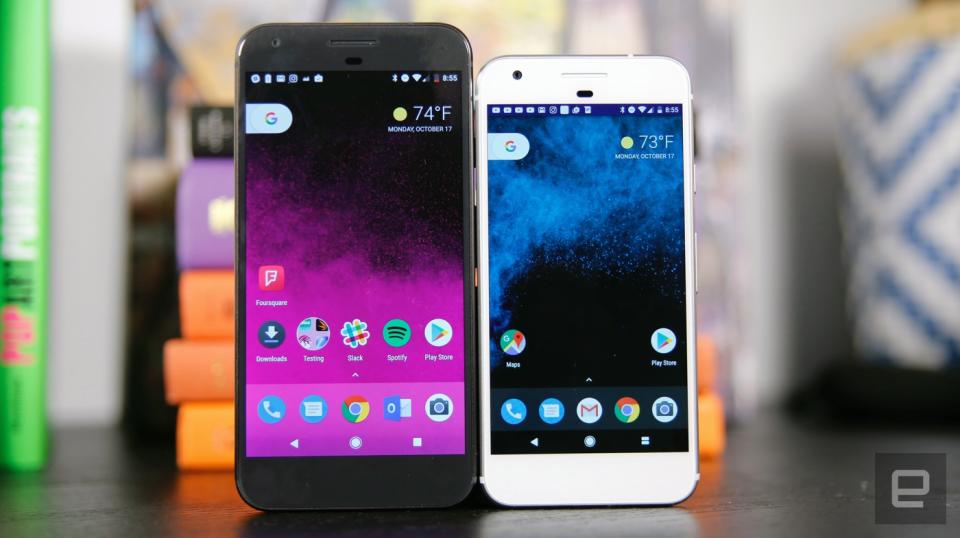
As the story goes, Google only really got to contribute to Nexus phones once they were 90 percent done. That's crazy, isn't it? I loved the Nexus line from day one, but it always felt clear that Google was just experimenting with things while its hardware partners took on most of the risk. Now Google is sticking its own neck out there, and the market -- no, the people -- won't stand for mediocrity.
Thankfully, the Pixels are much, much better than that. They certainly have their share of shortcomings, like a drab design, wimpy water resistance and some hefty price tags. The thing is, Google had to start somewhere, and the foundation it built with these two phones is a surprisingly strong one. These aren't just great first attempts at smartphones; these are great smartphones, period, and every other Android device maker out there should be a little worried.



































































